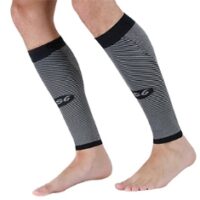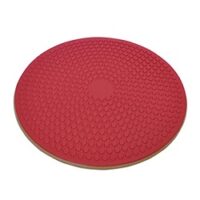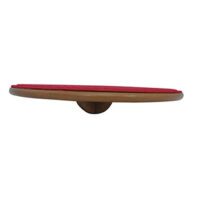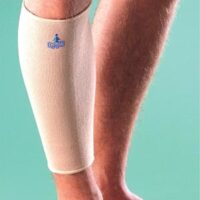Posterior Shin Splints
Article by John Miller

Posterior Shin Splints
What are Posterior Shin Splints?
Posterior shin splints occur when the tibialis posterior muscle on the inside rear of the shinbone weakens or lacks muscle endurance. Consequently, the foot arch, which this muscle controls during the weight-bearing support phase, collapses, leading to torsional stresses on the shinbone.
Suppose you experience pain along the inside rear of your shinbone. In that case, it is likely that you are suffering from posterior shin splints or tibia stress fractures. It is important to note that posterior shin splints can also occur alongside tibialis posterior tendinopathy. These conditions, collectively known as medial tibial stress syndrome (MTSS), warrant professional attention and appropriate treatment.
Notably, posterior shin splints are the most common cause of painful shin bones, particularly among individuals involved in running sports. However, it is worth mentioning that anterior shin splints present similar symptoms but manifest in different locations.
To address these conditions and find relief from shin pain, seeking professional guidance is highly recommended. Consulting with a physiotherapist will provide personalised advice and strategies to effectively manage and recover from posterior shin splints or related injuries.
What Causes Posterior Shin Splints?
Posterior shin splints occur due to overstraining the muscles where they attach to the shin. Biomechanical factors and training errors contribute to the development of posterior shin splints. Inadequate foot and leg biomechanics, associated with overuse or overtraining, are the most common causes.
Some common causes of posterior shin splints include:
- Increasing training intensity too quickly
- Running on hard or angled surfaces
- Insufficient rest between training sessions
Biomechanical factors:
- Overpronation or oversupination of the feet
- Decreased flexibility in the ankle joint
- Poor muscle control in the hip, knee, and leg
- Inadequate buttock control during the stance phase
- Poor core stability
- Tight calf muscles and hamstrings
- Weak quadriceps and foot arch muscles
Equipment:
- Wearing inappropriate footwear
What Structures Do Posterior Shin Splints Injure?
Posterior shin splints involve three main structures:
- Muscles: Repeated overuse can lead to injuries in the lower leg muscles, resulting in muscle tenderness, inflammation, or knots. The tibialis posterior muscle is commonly affected in posterior shin splints.
- Tenoperiosteum: The periosteum is the hard outer layer of the bone, and tendons connect muscles to bones, attaching to this periosteum. In posterior shin splints, there is often inflammation of the tenoperiosteum, which causes pain in different areas of the shin.
- Shinbone (tibia): Damage to the shinbone typically occurs in the lower one-third of the bone. The severity of bone damage can range from mild stress reactions to severe stress fractures. Standard X-rays may not always detect bone damage, requiring further investigation with a bone scan or MRI.
What are the Symptoms of Posterior Shin Splints?
Posterior shin splints cause dull, aching pain in the front of the lower leg along the inside-rear (medial/posterior) edge of the shinbone (tibia). Depending on the exact cause, the pain may extend to the side of the shinbone or affect the associated muscles. The affected area is often tender to the touch.
The Four Stages of an Overuse Injury:
Your physiotherapist will provide guidance on the level of exercise you can perform. Here are some general guidelines until you consult with your physiotherapist:
Stage 1:
You may experience shin discomfort that disappears during the warm-up phase. At this stage, it is essential to identify and treat the injury to prevent it from worsening. We recommend seeking professional guidance to obtain an accurate diagnosis and implement appropriate treatment strategies.
Stage 2:
Shin discomfort may disappear during the warm-up but reappear at the end of the activity. You can continue the activity at a modified pain-free level while receiving treatment. Highly recommend professional assessment and treatment until you fully resume regular exercise and training.
Stage 3:
Shin’s discomfort worsens during the activity. You must immediately stop the activity if the injury progresses to stage three. Seeking professional guidance is crucial to confirm the diagnosis and ensure that the condition has not developed into bone stress fractures. Following a comprehensive rehabilitation program is recommended to return to normal activity levels gradually.
Stage 4:
Constant pain or discomfort regardless of activity. All activity should cease immediately; professional guidance is necessary to rule out stress fractures or more severe tibia fractures. Non-weight bearing on crutches or using an air cast may be required. It is essential to schedule an appointment with a healthcare professional specialising in shin pain to thoroughly investigate and rehabilitate the condition based on their assessment.
How are Posterior Shin Splints Diagnosed?
Physiotherapists typically diagnose posterior shin splints by reviewing your medical history and conducting a physical examination. During the investigation, your physiotherapist will assess the location and nature of your pain.
Your healthcare team may sometimes utilise additional diagnostic tests such as X-rays, bone scans, or MRIs to rule out other potential causes, including stress fractures. We recommend consulting with your physiotherapist to receive personalised advice regarding your shin pain.
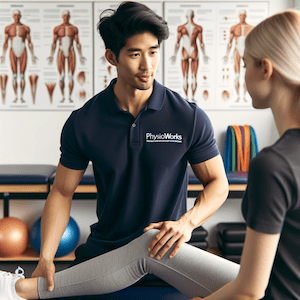
How to Treat Posterior Shin Splints
The fastest way to heal posterior shin splints involves several phases of treatment.
Phase 1 – Early Injury Protection:
ain Reduction & Anti-inflammatory Phase During this phase, it is crucial to rest, apply ice, and protect the affected area. Your physiotherapist will guide the best approach for you. Consider using anti-inflammatory medication or natural substances like arnica to alleviate pain and swelling. Applying ice for 20-30 minutes every 2 to 4 hours can reduce pain and swelling. Supportive taping using a kinesio style can help reduce stress on the shin bone and support the injured soft tissue.
Phase 2: Regain Full Range of Motion
In this phase, the focus is on allowing the injured shin muscles to heal and regain strength. Techniques such as massage, muscle stretches, neurodynamic mobilisations, and specific exercises are employed to optimise the remoulding of scar tissue and prevent the formation of poorly formed scars that could re-tear. It may take several weeks for the healing process to occur.
Phase 3: Normalise Foot Biomechanics
Posterior shin splints often result from poor foot biomechanics, such as having a flat foot. To prevent a recurrence, a thorough assessment of the foot is necessary.
Depending on the evaluation, your physiotherapist may determine that you require a foot orthotic (shoe insert) or recommend participating in the Active Foot Posture Stabilisation program. Your physiotherapist will discuss the benefits and drawbacks of each option with you.
Phase 4: Restore Muscle Strength
Strengthening exercises targeting the calf, shin, quadriceps, gluteal, and other lower limb muscles are essential for a safe return to sports or training. Restoring muscle strength in these areas helps to prevent further injury.
Phase 5: Modified Training, Program & Return to Sport
Most cases of posterior shin splints occur due to excessive training loads. To avoid a recurrence as you resume your sport, your physiotherapist will guide you with training schedules and exercises that address the critical rehabilitation components. This phase may include sport-specific activities and a progressive training regime tailored to your chosen sport, enabling a safe and injury-free return.
Your physiotherapist will work with you to discuss your goals, timeframes, and training schedules, optimising your chances for a complete return to sport. The ultimate goal is to have you performing at full speed, power, agility, and function, with the added assurance that a comprehensive rehabilitation program has minimised the risk of future injury.
How Long does it take for Posterior Shin Splints to Heal?
The time it takes for posterior shin splints to heal varies depending on several factors, which your physiotherapist will assess during their clinical evaluation. Determining progression from one stage of rehabilitation to the next will be based on your circumstances and functional improvement.
It is crucial to carefully monitor your activity and exercise progression, as advancing too quickly to the next level can result in re-injury and frustration. The severity of your posterior shin splints, your adherence to treatment, and the demands of your workload or activities will ultimately influence the duration of your rehabilitation.
Are Posterior Shin Splints Serious?
If left untreated and with continued overtraining, shin splints can potentially develop into tibial stress fractures, requiring a minimum of six weeks of rest. In rare cases, if muscle sheaths become compressed by swollen muscles, it can lead to muscle compartment syndrome. This severe shin condition may necessitate surgical intervention to prevent permanent muscle damage.
Conclusion
In conclusion, posterior shin splints can be painful and require proper diagnosis and treatment. Seeking professional guidance from a physiotherapist is highly recommended to obtain an accurate diagnosis, implement appropriate treatment strategies, and ensure a safe and effective recovery. They will provide personalised advice, guide you through rehabilitation, and help you gradually return to regular exercise and training. Don’t let shin pain hold you back from enjoying your activities. Take the proactive step of consulting with a physiotherapist to get the support you need and get back on track to optimal shin health.
More info:
Shin Pain Causes
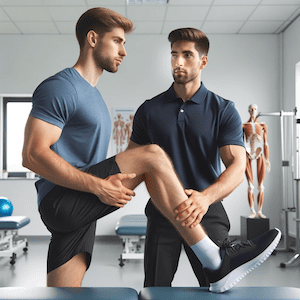

Shin Pain and Injury
Common Sources and Conditions
Understanding the common shin pain causes is crucial for effective management and prevention. This section discusses the various factors that contribute to shin pain.
General Overview of Shin Pain
Exploring the basics and general aspects of shin pain
Specific Conditions Related to Shin Pain
Shin Splints
Bone-Related Issues
Tendon and Muscle Problems
- Tibialis Posterior Tendinopathy
- Calf Muscle Tear
- Muscle Strain
- DOMS - Delayed Onset Muscle Soreness
- Cramps
Achilles Tendon Issues
Other Related Conditions
Shin Pain Due to Overuse and External Factors
Systemic and Neurological Conditions Leading to Shin Pain
Shin Pain Treatment
Effective treatment options vary depending on the cause of shin pain. This part provides guidance on treating different types of shin pain.
- Treating Shin Splints: Guidelines for managing and recovering from shin splints.
- Stress Fracture Care: Tips for healing and rehabilitation.
- Muscle Injury Treatment: Advice on treating strains and overuse injuries.
- Post-Fracture Rehabilitation: Strategies for dealing with shin pain following leg fractures.
Shin Pain FAQs
This section answers frequently asked questions about shin pain, providing valuable information for those experiencing or concerned about shin pain.














